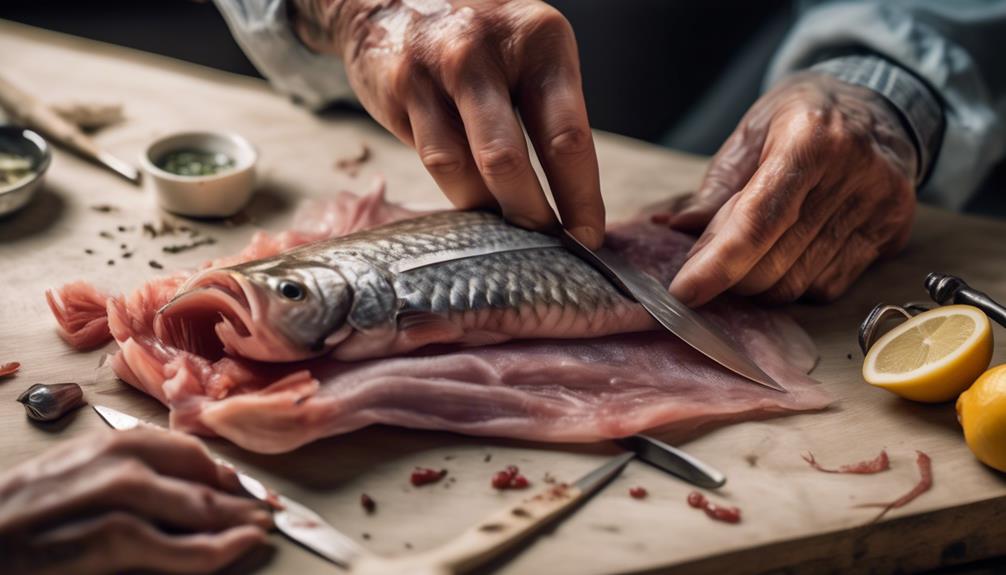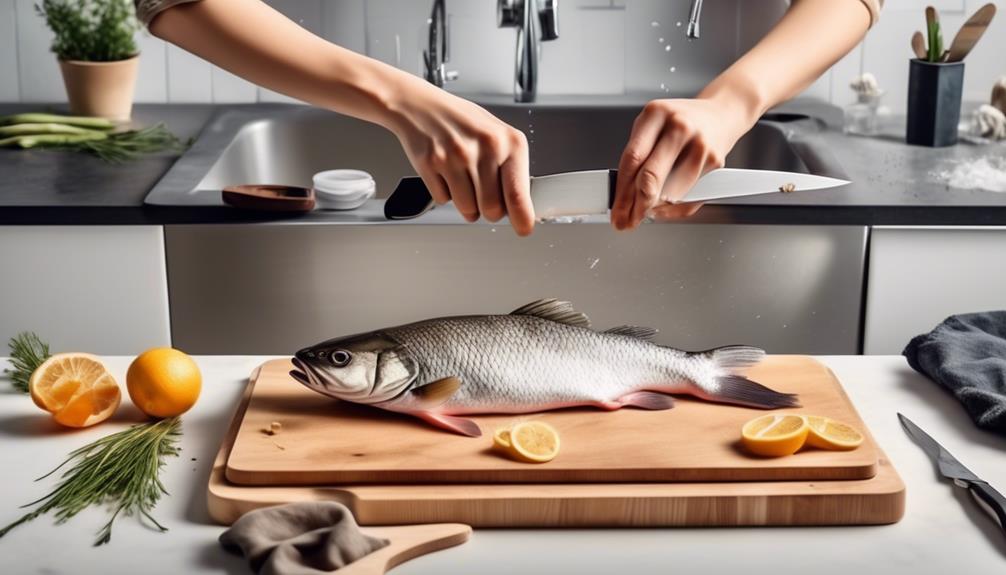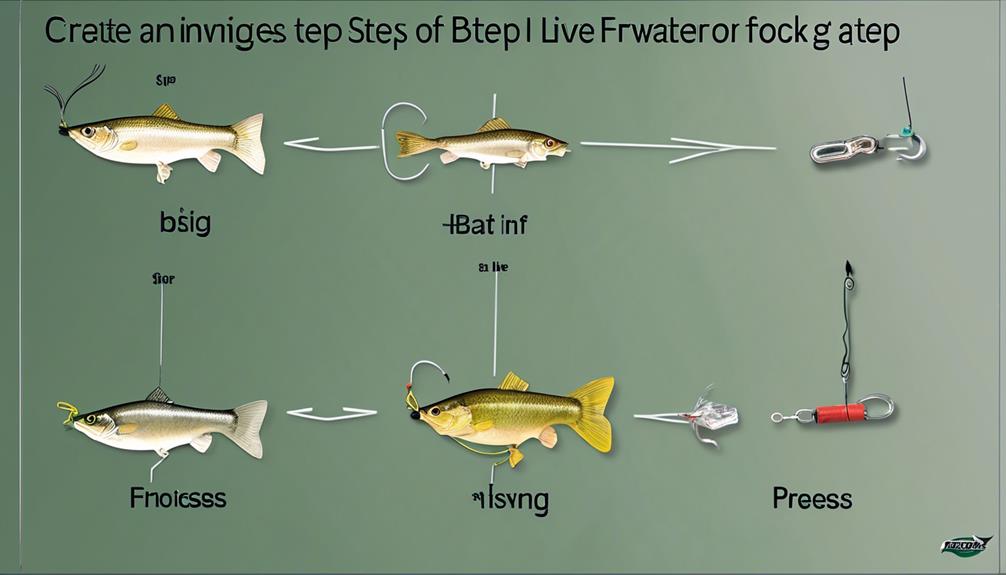You know the saying, 'Give a man a fish and you feed him for a day; teach a man to fish and you feed him for a lifetime.'
But what happens after you catch that fish? How do you turn it into a meal?
The process for cleaning freshwater fish is an essential skill for any angler or seafood enthusiast. From gathering the necessary tools to storing the fillets, there are several steps involved in ensuring that the fish is ready to be cooked and enjoyed.
So, let's walk through the process together and make sure you have all the know-how to make that freshly caught fish a delicious meal.
Gathering the Necessary Tools
To get started, gather the tools you'll need for cleaning freshwater fish. Proper sanitation is crucial when handling fish to ensure the cleanliness and safety of the meat. Begin by preparing a clean and sanitized workspace. Wash your hands thoroughly with soap and warm water before and after handling the fish. Use a cutting board that's specifically designated for fish to prevent cross-contamination with other foods. Additionally, make sure all your tools, such as knives and utensils, are clean and sanitized before use.
When it comes to knife safety, it's essential to use sharp knives. Contrary to what some may think, a sharp knife is safer than a dull one because it requires less force, reducing the risk of slipping and injuring yourself. However, always handle sharp knives with care and respect. Keep your fingers away from the blade and use a proper cutting technique to avoid accidents. When not in use, store your knives in a safe place, such as a knife block or a sheath, to prevent accidental cuts when reaching for them.
Preparing the Work Area
After gathering the necessary tools for cleaning freshwater fish, ensure that your work area is clean and well-organized to maintain proper sanitation and safety standards. Setting up your workspace properly is crucial for a successful and hygienic fish cleaning process. Here are some key steps to prepare your work area:
- Cleaning supplies: Gather all the required cleaning supplies such as a cutting board, sharp knives, paper towels, and a garbage bin. Ensure that all the supplies are clean and in good condition before starting the process. This will help in maintaining the hygiene of the work area and the fish.
- Workspace organization: Clear the work area of any unnecessary items and ensure that it's well-organized. Arrange the cleaning supplies in a convenient and accessible manner. Having a clean and organized workspace won't only make the process more efficient but also reduce the risk of accidents.
- Safety precautions: Before starting, make sure the work area is well-ventilated. Additionally, ensure that there are no tripping hazards and that the work surface is stable. It's also important to keep a first-aid kit nearby in case of any accidents.
Scaling the Fish
Begin by firmly holding the fish by the tail to keep it steady. With a firm grip on the tail, use a fish scaler or a blunt knife to remove the scales. Working from the tail towards the head, scrape the scaler or knife against the grain of the scales. Apply enough pressure to remove the scales, but be careful not to damage the skin or flesh of the fish. Scales can be quite slippery, so ensure a secure grip on the fish to prevent it from slipping out of your hand. Scaling the fish is an essential step in preparing it for cooking techniques such as pan-frying, grilling, or baking. Removing the scales allows for better heat penetration and seasoning absorption during cooking.
Understanding fish anatomy is crucial when scaling a fish. Fish scales are part of the fish's integumentary system, which serves to protect the fish from the external environment. They're made of a tough, transparent material called keratin, similar to the material found in human fingernails and hair. The scales overlap each other, providing a flexible yet protective layer. By removing these scales, you're exposing the skin and flesh, allowing for cooking techniques to be more effective.
Once the fish is scaled, make sure to thoroughly clean the work area to remove any loose scales before moving on to the next step in the cleaning process.
Gutting the Fish
Now that the fish has been scaled, the next step is to gut it to prepare it for cooking. Gutting the fish is crucial to ensure that the meat is clean and free from any unwanted parts. Here are the steps to effectively gut a freshwater fish:
- Gutting Technique: Lay the fish on a flat, clean surface and make a small incision from the anus to the base of the head. Carefully remove the entrails, being mindful not to puncture the internal organs. Rinse the cavity thoroughly with cold water to remove any remaining blood or debris.
- Fish Freshness: When gutting the fish, pay close attention to its freshness. Fresh fish will have clear, bright eyes, red gills, and firm flesh. Foul odors and sunken eyes indicate that the fish may not be fresh, and it's best to avoid consuming it.
- Gutting Tools and Fish Anatomy: A sharp knife is the primary tool for gutting a fish. Ensure that the knife is long enough to make clean cuts and precise incisions. Understanding the fish's anatomy is essential to avoid damaging any edible parts and to ensure a thorough gutting process.
Removing the Head and Fins
Are you ready to remove the head and fins from the gutted fish to prepare it for cooking?
First, let's tackle the fins. Using a sharp knife, carefully cut off the fins by slicing closely along the body of the fish. Be cautious to avoid any accidental cuts to yourself.
When removing the head, make a diagonal cut just behind the gills to separate the head from the body. This process requires good knife skills and an understanding of fish anatomy to ensure that the cuts are made cleanly and efficiently.
Once the head and fins are removed, it's crucial to consider waste disposal and the environmental impact. Proper waste disposal involves ensuring that the fish parts are disposed of responsibly. If possible, consider composting the fish waste, as it can be a valuable addition to a compost pile. If composting isn't an option, check with local regulations for the proper disposal method.
Additionally, being mindful of the environmental impact is essential. Wasteful disposal of fish parts can have negative consequences on the environment. By being conscientious about waste disposal, you can contribute to reducing environmental impact.
With the head and fins removed, you're now one step closer to cooking your freshwater fish. This process not only enhances the quality of the fish for cooking but also demonstrates a responsible approach to waste disposal and environmental impact. Now that you've completed this step, you're ready to move on to the next stage of preparing your freshwater fish for a delicious meal.
Rinsing the Fish
After removing the head and fins, thoroughly rinse the freshwater fish under cold running water to remove any remaining blood and impurities. Proper rinsing techniques are essential to ensure that the fish is clean and safe for consumption. When rinsing the fish, hold it under the running water and gently rub the surface to remove any traces of blood or debris. Pay close attention to areas around the gills and belly, as these areas can often retain blood and impurities.
The water temperature for rinsing is crucial for maintaining the quality of the fish. Cold running water is the ideal choice for rinsing freshwater fish, as it helps to preserve the texture and flavor of the fish. Avoid using warm or hot water, as this can cause the fish to become mushy and can also promote bacterial growth. Additionally, cold water helps to firm up the flesh of the fish, making it easier to handle and prepare for cooking.
Once the fish has been thoroughly rinsed, pat it dry with paper towels to remove excess moisture. Properly rinsing the fish sets the stage for the next steps in the cleaning process, ensuring that the fish is ready to be filleted, cooked, or stored.
Filleting the Fish

To fillet the fish, carefully make an incision behind the gills and run the knife along the backbone towards the tail, ensuring a smooth, precise cut. Once the fillet is separated from the body, use your knife skills to remove the rib bones by gently cutting along the ribcage to release the fillet. This ensures that you have a boneless piece of fish ready for various culinary applications.
When it comes to cooking techniques for freshwater fish fillets, there are several options to explore. Grilling the fillets imparts a delicious smoky flavor, while pan-searing creates a crispy skin that complements the delicate flesh. Baking or broiling the fillets with herbs and citrus can enhance their flavor profiles, infusing them with aromatic and zesty notes. Experimenting with different seasoning blends and marinades can further elevate the taste of the fillets, allowing you to customize the flavor profiles to your liking.
In terms of culinary applications, freshwater fish fillets are incredibly versatile. They can be used in classic dishes such as fish tacos, fish and chips, or fish sandwiches. Alternatively, you can get creative by incorporating the fillets into pasta dishes, salads, or stir-fries. Mastering the art of filleting freshwater fish not only improves your knife skills but also opens up a world of culinary possibilities, allowing you to showcase the natural flavors of the fish in diverse and delicious ways.
Storing the Fillets
When storing freshwater fish fillets, ensure they're placed in an airtight container or sealed plastic bag to maintain freshness and prevent potential contamination. Proper storage is crucial to preserving the quality of the fillets.
Here are some tips for storing your freshly cleaned fish fillets:
- Temperature Control: Store the fillets in the coldest part of your refrigerator, ideally at temperatures just above freezing. This helps to slow down bacterial growth and maintain the fish's freshness.
- Use of Ice: If you aren't planning to consume the fillets immediately, consider packing them in ice to keep them chilled. This is especially important if you're transporting the fillets from the fishing site to your home.
- Best Containers: Opt for airtight containers or vacuum-sealed plastic bags to store the fillets. These containers help to minimize exposure to air and prevent moisture loss, which can lead to freezer burn. Vacuum-sealed bags are particularly effective in prolonging the shelf life of fish fillets.
Proper storage of fish fillets is essential for maintaining their quality and flavor. By following these storage guidelines and using the best containers, you can ensure that your freshwater fish fillets remain fresh and delicious until you're ready to cook them.
Frequently Asked Questions
Can You Use the Same Tools and Process for Cleaning Saltwater Fish as Freshwater Fish?
Yes, you can use similar tools and methods for cleaning saltwater fish as freshwater fish. However, there may be differences in equipment due to the size and type of saltwater fish. Cooking methods for saltwater fish also vary.
Is It Safe to Eat the Skin of Freshwater Fish After Cleaning?
When cleaning freshwater fish, it's safe to eat the skin with its health benefits intact. Properly prepared skin can add flavor and texture to your dish. Try cooking techniques and recipes that incorporate the skin for a delicious meal.
Are There Any Special Considerations for Cleaning Larger Freshwater Fish, Such as Catfish or Carp?
When cleaning larger freshwater fish like catfish or carp, there are special considerations. Ensure you have a sharp knife for cutting through tough skin and remove any scales carefully to avoid getting injured by the sharp spines.
What Is the Best Way to Dispose of the Fish Waste After Cleaning?
After cleaning freshwater fish, the best way to dispose of the fish waste is by composting. This method reduces environmental impact and supports nutrient recycling. Avoid disposing of fish waste in sewage systems to protect water quality.
Are There Any Specific Cleaning Techniques for Removing Bones From Freshwater Fish Fillets?
When removing bones from freshwater fish fillets, choose a sharp knife to carefully slice along the bone. Season with your preference and cook by grilling or pan-frying for a delicious meal.
Conclusion
Now that you've learned the process for cleaning freshwater fish, you can confidently tackle this task on your own.
With the right tools and preparation, scaling, gutting, and filleting the fish can be a straightforward process.
Remember to rinse the fish thoroughly and store the fillets properly to maintain their freshness.
Enjoy your freshly cleaned fish and the delicious meals you can create with them!



